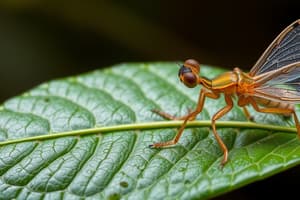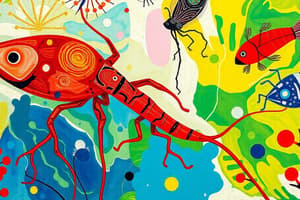Podcast
Questions and Answers
Which of the following is the most accurate definition of evolution?
Which of the following is the most accurate definition of evolution?
- The process by which organisms become more complex over time.
- The change in the heritable characteristics of biological populations over successive generations. (correct)
- The development of new species from existing ones.
- The survival of the fittest organisms in a population.
A population of butterflies contains individuals with varying wing patterns. Which of the following scenarios best illustrates natural selection?
A population of butterflies contains individuals with varying wing patterns. Which of the following scenarios best illustrates natural selection?
- A sudden disease outbreak kills the butterflies with the most common wing pattern.
- Butterflies with brighter wing patterns are more attractive to mates, leading to increased reproduction.
- Butterflies with duller wing patterns are better camouflaged from predators, leading to higher survival rates. (correct)
- A random mutation causes some butterflies to develop a completely new wing pattern.
In the hierarchical classification system, which level of classification is broader than family but narrower than class?
In the hierarchical classification system, which level of classification is broader than family but narrower than class?
- Genus
- Species
- Order (correct)
- Phylum
Two bird species are placed in the same genus, but different species. Which of the following is necessarily true?
Two bird species are placed in the same genus, but different species. Which of the following is necessarily true?
Why is maintaining biodiversity crucial for the health and stability of ecosystems?
Why is maintaining biodiversity crucial for the health and stability of ecosystems?
Which of the following best describes the relationship between genes, DNA, and heredity?
Which of the following best describes the relationship between genes, DNA, and heredity?
A scientist observes a population of insects gradually developing resistance to a pesticide over several generations. Which characteristic of life is best exemplified by this observation?
A scientist observes a population of insects gradually developing resistance to a pesticide over several generations. Which characteristic of life is best exemplified by this observation?
Which of the following is an example of how an organism maintains homeostasis?
Which of the following is an example of how an organism maintains homeostasis?
How do eukaryotic cells differ from prokaryotic cells concerning their structural organization?
How do eukaryotic cells differ from prokaryotic cells concerning their structural organization?
Which of the following is an example of an interaction studied in ecology?
Which of the following is an example of an interaction studied in ecology?
Which of the following is a potential consequence of habitat loss on biodiversity?
Which of the following is a potential consequence of habitat loss on biodiversity?
Which of the following correctly matches a subdiscipline of biology with its focus?
Which of the following correctly matches a subdiscipline of biology with its focus?
Metabolism encompasses both anabolic and catabolic processes. How do these processes differ?
Metabolism encompasses both anabolic and catabolic processes. How do these processes differ?
Flashcards
Biology
Biology
The scientific study of life and living organisms.
Characteristics of Living Organisms
Characteristics of Living Organisms
Shared traits that define living organisms, such as organization and metabolism.
Metabolism
Metabolism
The set of life-sustaining chemical reactions for maintaining life.
Cell
Cell
Signup and view all the flashcards
Eukaryotic Cells
Eukaryotic Cells
Signup and view all the flashcards
Genetics
Genetics
Signup and view all the flashcards
Ecology
Ecology
Signup and view all the flashcards
Biodiversity
Biodiversity
Signup and view all the flashcards
Evolution
Evolution
Signup and view all the flashcards
Natural Selection
Natural Selection
Signup and view all the flashcards
Genetic Drift
Genetic Drift
Signup and view all the flashcards
Taxonomy
Taxonomy
Signup and view all the flashcards
Binomial Nomenclature
Binomial Nomenclature
Signup and view all the flashcards
Study Notes
Introduction to Biology
- Biology is the scientific study of life, encompassing all living organisms.
- Key aspects of biology include: structure, function, growth, evolution, distribution, and reproduction.
- Biology explores the diversity of life on Earth, from microscopic organisms to complex ecosystems.
- Subdisciplines of biology include botany, zoology, microbiology, genetics, and ecology.
Characteristics of Living Organisms
- Living organisms exhibit several shared characteristics:
- Organization: Cells are the basic units of life, organized into tissues, organs, and organ systems.
- Metabolism: Living organisms acquire and use energy to carry out life processes. This includes both anabolic (building) and catabolic (breaking down) processes.
- Growth and Development: Organisms increase in size and complexity over time.
- Adaptation: Organisms adapt to their surroundings over generations. This often involves changes in physical structure or function.
- Response to Stimuli: Organisms respond to environmental changes. These responses may be immediate or delayed.
- Reproduction: Organisms produce offspring, ensuring the continuation of their species.
- Homeostasis: Maintenance of a stable internal environment despite fluctuations in the external environment.
- Evolution: Changes in inherited characteristics of a population over successive generations.
The Cell: The Fundamental Unit of Life
- The cell is the basic structural and functional unit of all known living organisms.
- Two major types of cells: prokaryotic (lacking a nucleus and other membrane-bound organelles) and eukaryotic (possessing a nucleus and other membrane-bound organelles).
- Prokaryotic cells are typically smaller and simpler than eukaryotic cells.
- Eukaryotic cells are more complex and include various organelles like mitochondria, endoplasmic reticulum, Golgi apparatus, etc.
- Each organelle performs specific functions essential for the cell's survival.
Genetics and Heredity
- Genetics is the study of genes, heredity, and variation in organisms.
- Genes are segments of DNA that carry the genetic instructions for building and maintaining an organism.
- DNA (deoxyribonucleic acid) is the molecule that carries the genetic code.
- Heredity is the passing of traits from parents to offspring.
- Genes determine the traits that are expressed in an organism.
- Mutations in DNA can lead to variations in traits, which can drive evolution.
Ecology and the Environment
- Ecology is the study of the interactions between organisms and their environment.
- Organisms interact with each other and their surroundings (physical and biotic factors).
- Ecosystems include all biotic and abiotic factors.
- Biodiversity is the variety of life on Earth at all its levels, from genes to ecosystems.
- Threats to biodiversity include habitat loss, pollution, and climate change.
Evolution
- Evolution is the change in the heritable characteristics of biological populations over successive generations.
- Evolution is driven by natural selection.
- Natural selection is the process that allows organisms with favorable adaptations to survive and reproduce better than others.
- Genetic drift is another factor that can cause changes in allele frequencies within populations, particularly in small populations.
Classification of Organisms
- Taxonomy is the science of classifying and naming organisms.
- A hierarchical system of classification is used to organize and categorize organisms based on evolutionary relationships.
- Organisms are grouped into domains (Bacteria, Archaea, Eukarya), then kingdoms, phyla, classes, orders, families, genera, and species.
- Binomial nomenclature is a system for naming species that uses two Latin names.
Biodiversity
- Biodiversity refers to the variety of life on Earth at all levels, from genes to ecosystems.
- Biodiversity is essential for ecosystem health and stability.
- Loss of biodiversity can have profound negative consequences for the environment and human well-being.
- Conservation efforts aimed at protecting biodiversity are crucial for maintaining healthy ecosystems.
Studying That Suits You
Use AI to generate personalized quizzes and flashcards to suit your learning preferences.




